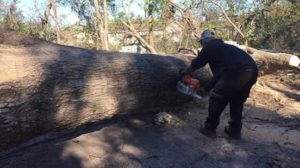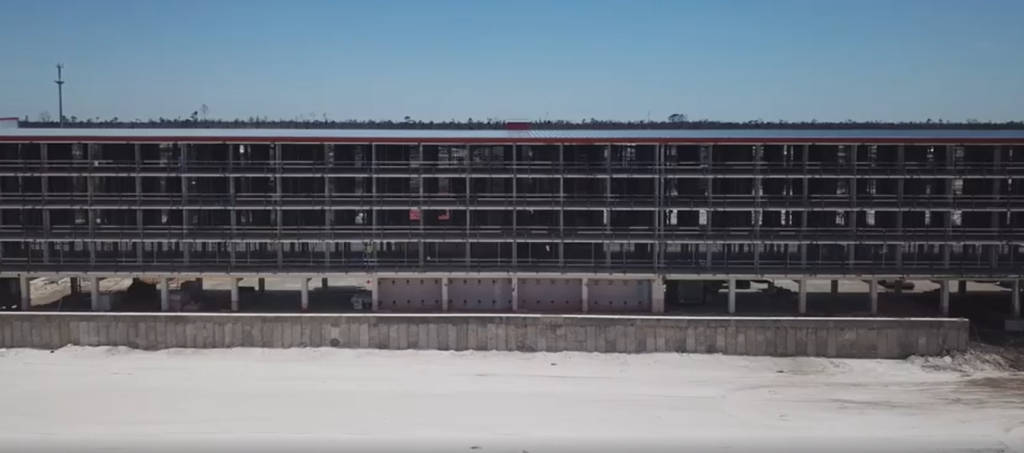Big work ahead in slow recovery from Hurricane Michael
As summer approaches, tourists are beginning to return to Mexico Beach, ground zero for Hurricane Michael, which struck a little more than eight months ago. Residents in the Panhandle are now keeping a wary eye out for summer wildfires that officials fear could easily get out of control with the tons of downed trees and other storm debris that remains. There’s fear of flooding from heavy rains, too. Meanwhile, Bay County officials are moving ahead on a 271-page blueprint for recovery.
On a recent weekend visit to Mexico Beach, we found some out-of-town tourists visiting from Northern Florida and Georgia. While a good number of businesses have actually reopened, including the quaint coffee shops and restaurants, they report business is way down. Part of the problem is that motels, among them the large El Governor Motel that sits right on the beach, haven’t reopened. So the tourists that are here are day-trippers.
The windows and furnishings in the four-story motel that weren’t wiped away by Michael’s 160-mph winds, have been cleared away by contractors. Motel owners say they will rebuild toward opening next year. Parking is also a problem for tourists, including the spots that used to exist right along either side of coastal Highway 98 that allowed a quick walk to the beach. That road is still closed in parts.
Panhandle residents have come to the realization that nowhere near all of the debris is going to be cleaned-up by the heart of the summer season. Michael downed about 500 million trees, creating 72 million tons of forest debris by state estimates. That debris fueled a 600-acre wildfire in rural Bay County east of Panama City this past March.

Ongoing Tree Removal in Bay County, May 2019
Jim Karels, the Director of the state Division of Forestry, has warned in published reports that the underbrush has also grown up around the snapped trees in the months since Michael, contributing to the fire threat. Elsewhere in the core 8-county impacted area, the opposite situation: runoff from heavy springs rains have been dammed up by all the debris, creating localized flooding and in some areas, actually changing the floodplain itself. The state has spent $30 million so far clearing debris from waterways with no end in sight. Residents and local emergency management officials also worry about what would happen should another hurricane strike in this new season.
Some of the $19 billion federal disaster aid package passed by Congress earlier this month will be available to help in the cleanup, but that money is many months away from arriving and being designated by state and local officials. $480 million is being designated to help Florida timber growers recover from the devastation.
The Bay County Long-Term Recovery Task Force is moving forward on its strategy for the hard-hit county’s physical and economic recovery. Last week it issued a report with 322 proposals and various community initiatives to tackle the big repair job that Michael has become for so many, both in and out of government. The estimated price tag of $6.9 billion would come from federal, state, and private sources. It includes new infrastructure, such as a new $50 million water treatment plant for drinkable water and $1 billion to build 6,000 new housing units over the next decade to replace those damaged or destroyed by Michael. Nearly 70% of residential units in Panama City alone suffered significant damage. Today, about 5,500 Bay County families are considered homeless.
Without proper housing, business activity and economic development have taken big hits. The county’s unemployment rate is 5%, up from 2.8% before Michael’s landfall last October. Estimates of total economic damage from Michael still stand at $25 billion. Estimated insured losses are now $6.6 billion, from 147,325 claims filed through May 31. More than half of those claims – 88,400 – are from Bay County. About 15% of claims among all lines remain open, with 43% of commercial property claims and nearly 50% of business interruption claims – both big categories – remaining open. It’s easy to see how insurable claims could hit the estimated $10-$12 billion mark when all claims are finally settled.
LMA Newsletter of 6-17-19


